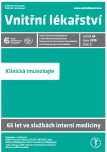Heterogeneity of lymphocytes as central operating units of the immune system
Authors:
Milan Buc
Authors‘ workplace:
Imunologický ústav LF UK v Bratislave, Slovenská republika
Published in:
Vnitř Lék 2019; 65(2): 86-97
Category:
Overview
Immune response is divided into natural and adaptive although such strict division is rather contentious as one type of immunity influences another one and vice-versa; moreover, there are cells and immune mechanisms, which stay somewhere in an interface. B and T lymphocytes represent principal cells of adaptive immunity. Not one of them form a uniform population. B cells comprise of three subpopulations (follicular, B1, marginal zone). Concerning T cells, the situation is more complicated. There are two basic populations, that expressing T cell receptors α, β and that expressing γ, δ receptors. T cells αβ are very heterogeneous; we can distinguish helper, cytotoxic and regulatory cells. Moreover, among T helper cell, are there seven subsets. Except the above-mentioned effector B and T cells, each group has its counterpart in the form of memory cells, wherein the memory T cell are of three types. The other group of lymphocytes represent so-called unconventional cells. NK, NKT a MAIT are their representatives; they are also heterogeneous. Ultimately, a novel group of cells appeared recently. It stays just on the interphase between natural and adaptive immunity. We know these cells under the name innate lymphoid cells (ILCs). They are also not uniform – three basic populations are well characterized: ILC1, ILC2, ILC3. Moreover, in the frame of each family, we can distinguish more subsets. Enumeration of said cell types indicates complexity and mutual interconnection of immune processes in order to maintain biological integrity of an individual.
Keywords:
B cells – ILC cells – MAIT – NK – NKT – subsets of lymphoid cells – T cells
Sources
22. Kumar BV, Connors TJ, Farber DL. Human T Cell Development, Localization, and Function throughout Life. Immunity 2018; 48(2): 202–213. Dostupné z DOI: <http://dx.doi.org/10.1016/j.immuni.2018.01.007>.
25. van den Broek T, Borghans JAM, van Wijk F. The full spectrum of human naive T cells. Nat Rev Immunol 2018; 18(6): 363–373. Dostupné z DOI: <http://dx.doi.org/10.1038/s41577–018–0001-y>.
28. Kallies A, Good-Jacobson KL. Transcription Factor T-bet Orchestrates Lineage Development and Function in the Immune System. Trends Immunol 2017; 38(4): 287–297. Dostupné z DOI: <http://dx.doi.org/10.1016/j.it.2017.02.003>.
44. Nielsen MM, Witherden DA, Havran WL. γδ T cells in homeostasis and host defence of epithelial barrier tissues. Nat Rev Immunol 2017; 17(12): 733–745. Dostupné z DOI: <http://dx.doi.org/10.1038/nri.2017.101>.
47. Poli A, Michel T, Patil N et al. Revisiting the Functional Impact of NK Cells. Trends Immunol 2018; 39(6): 460–472. Dostupné z DOI: <http://dx.doi.org/10.1016/j.it.2018.01.011>.
64. Ebbo M, Crinier A, Vely F et al. Innate lymphoid cells: major players in inflammatory diseases. Nat Rev Immunol 2017; 17(11): 665–678. Dostupné z DOI: <http://dx.doi.org/10.1038/nri.2017.86>.
67. Buc M. Crohns disease and ulcerative colitis – current view on genetic determination, immunopathogenesis and biologic therapy. Epidemiol Mikrobiol Imunol 2017; 66(4): 189–197.
76. Buc M. Charakteristika a funkcia ILC-buniek za fyziologických a patologických podmienok. Alergie 2017; 19(1): 24–30.
Labels
Diabetology Endocrinology Internal medicineArticle was published in
Internal Medicine

2019 Issue 2
Most read in this issue
- Anaphylactic symptoms and anaphylactic shock
- Adverse effects of immunoglobulin therapy
- Current trends in immunosuppressive treatment
- Primary immunodeficiencies in adults
